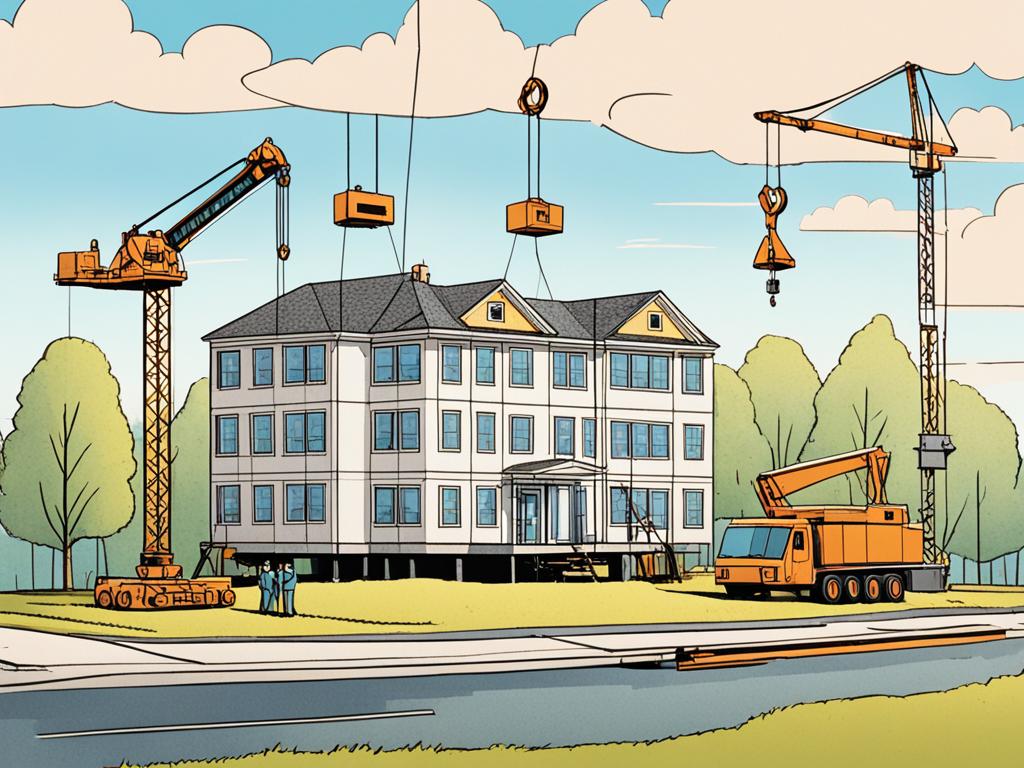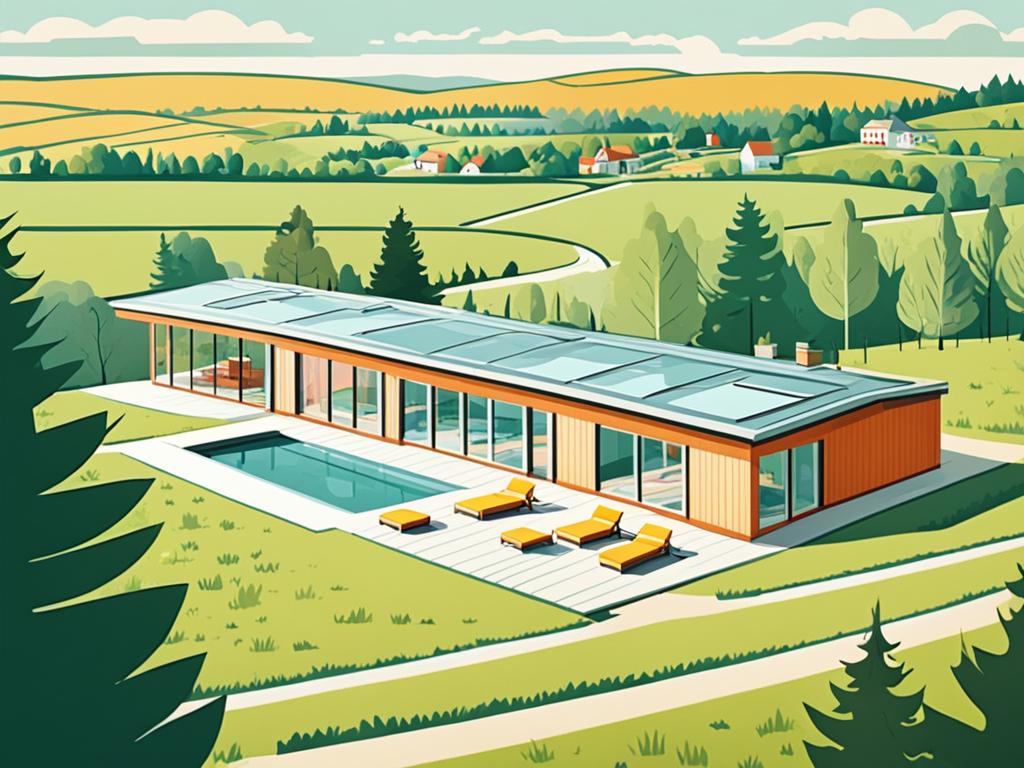In order to determine where you can put a prefab home, it is important to understand the zoning codes and regulations in your local area. Prefab homes can be built almost anywhere, as long as the site has enough space to accommodate the modules and provides proper access for delivery. Researching the zoning laws in your town can help you understand the local regulations for building permits. It is good news that prefab homes can obtain the same zoning approval as conventional homes, meaning you don’t need any special permits. However, it is essential to comply with local zoning laws and regulations when placing a prefab home.
Key Takeaways
- Research local zoning laws and regulations to understand where prefab homes can be placed.
- Prefab homes can be built almost anywhere as long as the site has enough space and access for delivery.
- Comply with local zoning laws and regulations when placing a prefab home to avoid any issues.
- Prefab homes can obtain the same zoning approval as conventional homes.
- Ensure the site complies with local zoning laws and regulations for a successful prefab home placement.
Can Modular Homes Be Built Anywhere?
Modular homes are a versatile housing option that can be built in various locations, provided certain requirements are met. The answer to the question, “Can you put a prefab home anywhere?” is generally yes, as long as the site meets the necessary criteria.
Modular homes can be constructed in almost any location, as long as there is enough space to accommodate the modules. This flexibility allows homeowners to choose their desired location, whether it’s in the countryside, a suburban neighborhood, or even an urban area.
When considering where to put a prefab home, it is important to ensure that the site provides access for delivery. The modules of a modular home need to be transported to the site, so there should be clear access for trucks or other delivery vehicles.
In some cases, it may even be possible to build a modular home on top of an existing building or structure. This can be a creative way to make the most of limited space or repurpose an old structure.
However, it is crucial to comply with local building codes and regulations when selecting a new construction site for a modular home. Just like traditional homes, modular homes are subject to zoning laws. Therefore, it’s important to research and understand the specific zoning regulations in your area.
Modular homes are typically treated the same way as conventionally built homes when it comes to zoning laws. This means that they can be placed in residential areas designated for detached single-family houses.

Zoning Restrictions
Before choosing a site for a prefab home, it is crucial to check the local zoning laws and regulations to see if there are any restrictions regarding the location of the structure. Understanding the zoning restrictions in your area can help you determine where you can legally place a prefab home and avoid any potential issues in the future.
Some municipalities may require permits for building additions near existing structures. The zoning laws may also dictate the minimum lot size, setbacks, and height restrictions for prefab homes. It is essential to research and understand these regulations before making any decisions.
By familiarising yourself with the zoning restrictions, you can ensure that you choose a site that complies with the local regulations. This will help prevent any delays or legal complications when it comes to placing your prefab home.

In addition to zoning restrictions, you may also need to consider other factors such as utility access and environmental regulations when choosing a site for your prefab home. Consulting with local authorities or hiring a professional who is knowledgeable about zoning laws can provide valuable guidance throughout the site selection process.
Prefab Home on a Basement
When considering placing a prefab home on a basement, it is important to consider soil conditions and the type of foundation system used. Clay soils may not hold enough moisture to keep footings stable, so other options such as poured concrete slabs or reinforced concrete block walls may be more suitable. It is crucial to determine the suitability of the soil and the foundation system before placing a prefab home on a basement.

How Are Modular Homes Different from Houses Built On-site?
Modular homes offer a unique approach to construction, utilizing standardized components that are assembled on-site. This sets them apart from traditional stick frame homes, which are built by framing out walls, floors, ceilings, and roof trusses before adding the exterior siding and finishing materials.
When it comes to location, prefab homes have the advantage of being able to be placed anywhere where stick-built houses are allowed according to most zoning codes. However, it’s crucial to consider several factors when selecting a site for a modular home to ensure optimal placement.
- Accessibility: Ensure the site provides convenient access for the delivery and installation of the modular home. Additionally, consider the accessibility of utilities such as electricity, water, and sewer connections.
- Utilities: It’s important to confirm the availability and capacity of utilities on the site to accommodate the needs of the modular home.
- Compatibility: Consider the surrounding area and the compatibility of the modular home with the existing architecture and landscape. This can help ensure that the new structure blends seamlessly into its surroundings.
By taking these site selection factors into account, you can choose the ideal location for your modular home, ensuring it fits harmoniously into its new environment. 
How Much Does a Modular Home Cost to Build?
The cost of building a modular home can vary depending on several factors. One of the key considerations is the location of the prefab home and the land requirements. The cost of land can vary significantly depending on the area, with prices higher in more desirable locations. It’s important to factor in the cost of purchasing or leasing the land when planning your budget for a modular home.
Another factor that affects the cost of building a modular home is the type of home you choose. Different models and designs can have varying price points. Some modular home builders offer a range of options, from basic models to more luxurious ones, allowing homeowners to customise and personalise their homes according to their preferences and budget.
Financing options are often available from modular home builders, making it easier to manage the cost of construction. They may offer loans or work with financial institutions that are experienced in financing prefab homes. This can be advantageous, particularly for first-time homeowners who might need assistance in securing a loan for their new home.
Different floor plans are typically offered by modular home builders, providing homeowners with a variety of options to choose from. This allows individuals to find the ideal layout that suits their needs and lifestyle. Customising the floor plan can also play a role in the overall cost of the modular home construction. Adding extra rooms or features may increase the price, so it’s essential to consider your budget when making these decisions.
Overall, the cost of building a modular home can range from affordable to higher-end, depending on various factors such as location, type of home, customisation options, and land requirements. It’s crucial to carefully evaluate these factors and work with a reputable modular home builder to get an accurate estimate tailored to your specific needs and budget.

How Long It Takes to Build a Modular Home
The construction time of a modular home can vary depending on several factors. Factors such as the size of the house, the number of rooms, and the customizations you choose can impact the overall timeline. However, in general, building a modular home typically takes less time compared to traditional on-site construction.
While most modular home companies provide a rough estimate of the construction timeline, it is always best to consult with the builder directly to get a more accurate idea of how long your specific project will take. They will consider the unique aspects of your home design and provide a more tailored timeline for completion.
In contrast to conventional site-built homes, modular homes are constructed off-site in a controlled factory setting. This allows for increased efficiency in the construction process. The modules are typically built simultaneously while the foundation is being prepared on-site. Once the modules are complete, they are transported to the site for installation and final touches.
With the streamlined construction process of modular homes, you can expect the overall build time to be significantly shorter than that of a site-built home. This quicker construction time not only saves you time but also reduces the amount of inconvenience and disruption caused during the building process.

Overall, building a modular home offers a faster and more efficient alternative to traditional on-site construction. By opting for a modular home, you can expedite the construction process without compromising on quality or customization options.
Conclusion
In summary, prefab homes offer the flexibility to be placed almost anywhere, as long as you adhere to local zoning laws and regulations. It is essential to research and understand the specific restrictions in your area before choosing a site for your prefab home. Factors such as access, soil conditions, and foundation systems should also be taken into consideration, especially if you plan to place your prefab home on a basement.
The cost and timeline for building a modular home can vary, but with financing options and a variety of floor plans available, you can customise your home to suit your needs and budget. By carefully planning and considering all aspects, you can find the perfect site for your prefab home and embark on an exciting journey of building your dream home.
So, whether you are looking to place your prefab home in a rural or urban area, remember that with proper planning and compliance with local regulations, you can confidently place your prefab home and create a space that you can call your own.
FAQ
Can you put a prefab home anywhere?
Prefab homes can be built almost anywhere, as long as the site has enough space to accommodate the modules and provides proper access for delivery.
Where can you put a prefab home?
Prefab homes can be placed almost anywhere, as long as the site complies with local zoning laws and regulations.
Are there regulations for placing prefab homes?
Yes, it is essential to comply with local zoning laws and regulations when placing a prefab home.
Are there zoning restrictions for prefab homes?
It is crucial to check the local zoning laws and regulations before choosing a site for a prefab home to ensure there are no restrictions on the location.
Can modular homes be built on a basement?
Yes, it is possible to place a prefab home on top of an existing basement structure. However, it is important to consider soil conditions and the type of foundation system used.
How are modular homes different from houses built on-site?
Modular homes are constructed using standardized components and assembled on-site, while traditional stick frame homes are built by framing out walls, floors, ceilings, and roof trusses.
How much does a modular home cost to build?
The cost of building a modular home can vary depending on factors such as location, type of home, and land requirements.
How long does it take to build a modular home?
The time it takes to build a modular home can vary depending on factors such as the size of the house and customizations, but it generally takes less time compared to traditional on-site construction.




